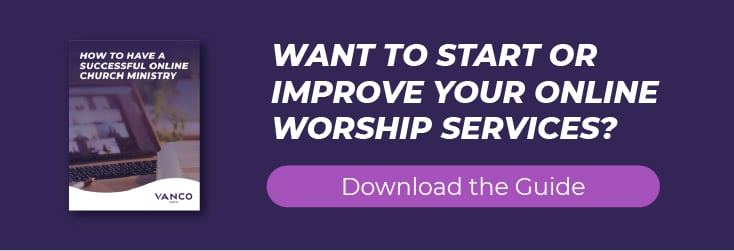- Decide on a Cadence
- Promote to the Congregation and Beyond
- Choose a Video or Phone Conference Platform
- Organize Virtual Gatherings
- Build Memberships Through Online Groups
- Get the Resources You Need
- FAQs

Setting up a prayer ministry online or any other virtual group, such as a Bible study or committee, is easy to do and won’t cost you a thing. To help you create your own virtual groups, such as how to start a women's ministry, we’ve provided a few steps we’ve taken from our work with tens of thousands of churches who have successfully engaged their members in person and remotely.
1. Decide on a Cadence
For your online prayer ministry or other virtual group, you’ll need to have a set meeting time. It’s important to be consistent. This helps people to integrate your prayer ministry or Bible study into their weekly or monthly routines. As the group grows, you may find that you’ll need to split it into multiple meetings to offer availability to members. Splitting the groups also has the benefit of encouraging more engagement among participants. When there are fewer individuals in the group, it encourages participation, rather than passive listening. This prompts them to interact when they might have just otherwise sat on the sidelines and listened.
2. Promote to the Congregation and Beyond
Once you have the schedule for a meeting set up, you’ll need to find a way to get new group members to join.
-
Announce It from the Pulpit
- Having your pastor or clergy announce the start of the group and issue reminders to join is the easiest way to get started.
-
Place Reminders in Bulletins
- Church bulletins handed out during Sunday services, or offered as attachments for virtual services, can help make members and guests aware of your online prayer ministry or other virtual groups.
-
Use Your Website
- Both members and guests interact with your website. Make sure you use the tool’s potential to inform. Place announcements detailing your group’s time and information.
-
Email Potential Participants
- Don’t just email your members. Reach out to past visitors and members. The online prayer ministry, Bible study or other another type of ministry is a great way for these people to reconnect with your congregation.
-
Send a Letter
- For some members or guests, a letter feels a more personal, which could lead to a response, while an email might be ignored.
-
Post on Social Media
- Your social media accounts, such as your Facebook page, offer a public space for those in the community and beyond to connect. That’s why a simple post, or something like a virtual prayer wall, can help draw new guests to your online prayer group. You can make sure your post stands out on your Facebook Timeline by pinning it. By pinning a post, it will remain at the top of your timeline until you remove it. Here’s how you can get started pinning posts for your church.
- Your social media accounts, such as your Facebook page, offer a public space for those in the community and beyond to connect. That’s why a simple post, or something like a virtual prayer wall, can help draw new guests to your online prayer group. You can make sure your post stands out on your Facebook Timeline by pinning it. By pinning a post, it will remain at the top of your timeline until you remove it. Here’s how you can get started pinning posts for your church.
-
Encourage Members to Pass the Message
- With the help of members, you can bring your online prayer ministry or Bible study to individuals within your community and beyond. One of the best ways you can encourage word of mouth is by providing the information in an easily accessible way. This would include putting the meeting details and login instructions in your social media posts or on your website. Doing this makes it simple for members to share with friends, family and acquaintances.
- With the help of members, you can bring your online prayer ministry or Bible study to individuals within your community and beyond. One of the best ways you can encourage word of mouth is by providing the information in an easily accessible way. This would include putting the meeting details and login instructions in your social media posts or on your website. Doing this makes it simple for members to share with friends, family and acquaintances.

3. Choose a Video or Phone Conference Platform
For your members to connect with each other during your online prayer group or virtual gathering, you’ll need video or phone conferencing.
-
Phone Conferencing
For less tech-savvy members, phone conferencing is easier. Using Zoom, you can dial in by phone and enter a meeting identification. However, there are limitations with a Zoom prayer meeting if you don’t have a paid account; the most significant is time. If you want to use their free solution, you’ll have to keep your call under 40 minutes. Fortunately, when it comes to phone conferencing, there are plenty of free solutions including this option.
-
Video Conferencing
If you’re looking for free video conferencing, there is an option many churches have adopted, and it’s really easy to use. Google Meet lets up to 100 users connect for free for up to an hour.
4. Organize Virtual Gatherings
As churches offer more prayer groups, Bible studies and other activities online, it becomes harder to organize each one. To ensure your church can support these extra services, you’ll need a little help. This is where free prayer apps for groups like Vanco Mobile come in handy. Aside from helping churches manage prayer groups, this free app sends notifications, has a calendar to organize your activities, allows group and private chats and offers a directory for members of your church to connect. Using mobile apps make it easier for even small churches to host prayer groups and other online activities for those in their community and beyond.
5. Build Memberships Through Online Groups
Don’t stop with your online prayer group or Bible study. Offer new remote services to members and those outside your congregation. These services help busy members stay connected with the church and offers them chances to grow spiritually. The online groups also allow churches to reach new individuals within their community and reconnect with old members who have stopped attending services. This is important because church membership is declining nationwide. From 1998 to 2018, church membership dropped from 69% to 52% of adults (Gallup).
One of the biggest problems churches have in gathering new members comes down to the making these folks feel welcomed. Tony Morgan studied the impact that following up with new visitors had on membership growth. He found that 90% of visitors returned if they received an immediate follow up from someone within the congregation and 60% of individuals returned when the follow up occurred within a few days.
Offering an online prayer ministry and other virtual gatherings is a powerful tool for church leaders. By extending invitations to join groups, you allow newcomers to enjoy warm welcomes from existing members as they participate.
6. Get the Resources You Need
Vanco has created a detailed guide that will help you offer virtual services to your members. Download the free eBook to learn about all the tools available to your church and how to best use them. Also receive best practices taken from the tens of thousands of churches we've worked with.
FAQs
What are the best times to schedule online prayer meetings?
When it comes to scheduling online prayer meetings, selecting the right time is crucial for maximum participation and engagement. While the ideal timing may vary depending on the specific community and its preferences, here are a few general recommendations:
- Consider convenience: Choose a time slot that is convenient for most participants, taking into account factors like work schedules, time zones and family commitments.
- Early morning or evening: Many people find it beneficial to start their day with a time of prayer or wind down in the evening with a spiritual gathering. These time slots often work well for online prayer meetings.
- Lunch breaks: For those who have busy mornings and evenings, scheduling during lunch breaks can be a great option. It allows participants to take a break from their daily routines and connect with others through prayer or prayer requests.
Remember, it's important to engage with your prayer group members and ask for their input regarding the best meeting times. This will help ensure that the chosen schedule accommodates as many participants as possible.
How to make your online prayer group more inclusive?
Building inclusivity within an online prayer group is essential to create a welcoming and supportive community. Here are a few strategies to foster inclusivity:
- Embrace diversity: Encourage individuals from various backgrounds, cultures, and experiences to join your prayer group. Emphasize the importance of respecting and appreciating different perspectives.
- Create a safe space: Establish guidelines for respectful communication and ensure that all members feel comfortable expressing themselves without fear of judgment. Foster an atmosphere of trust and confidentiality.
- Provide accessibility options: Make sure your online prayer platform is accessible to individuals with disabilities. Captioning services, screen reader compatibility, and language interpretation services can enhance inclusivity.
- Celebrate different traditions: Acknowledge and celebrate different religious traditions and customs within your prayer group. This can be done by incorporating rituals or practices from various faiths during your online meetings.
- Encourage active participation: Create opportunities for all members to actively participate in prayer sessions. Provide space for sharing personal prayers, reflections, and testimonies.
By implementing these strategies, you can cultivate an inclusive and supportive online prayer community.
What are some common challenges in online prayer groups and how to overcome them?
Online prayer groups may encounter certain challenges that can be overcome with proactive measures. Here are some common challenges and potential solutions:
- Technical difficulties: Connectivity issues, audio problems or video lag can disrupt the flow of online prayer meetings. Encourage participants to have a stable internet connection and provide troubleshooting guidelines for common technical issues.
- Lack of engagement: It can be challenging to maintain active participation in online prayer groups. Encourage members to share their prayers, engage in discussions, and create interactive elements like breakout rooms or prayer partners.
- Distractions: Participants may face distractions in their home environment, such as noise or interruptions. Suggest finding a quiet space and setting boundaries with family members to minimize disruptions during prayer sessions.
- Time zone differences: When participants are located in different time zones, scheduling meetings can be a challenge. Consider rotating meeting times to accommodate everyone or record sessions for those unable to attend live.
- Building connections: Developing deep and meaningful connections within an online setting can be difficult. Encourage members to engage in small group discussions, prayer chains, or virtual social events to foster connection outside of formal prayer sessions.
By being proactive and addressing these challenges, online prayer groups can create a meaningful and connected prayer experience for all participants.
How can technology enhance online prayer experiences?
Technology can play a significant role in enhancing online prayer experiences. Here are a few ways technology can be utilized:
- Video conferencing platforms: Platforms like Zoom, Microsoft Teams or Google Meet enable face-to-face interactions, allowing participants to see and hear each other during prayer meetings, fostering a sense of community.
- Interactive prayer platforms: Online tools specifically designed for prayer facilitate engagement and collaboration. These platforms can provide features like shared prayer requests, real-time chat boxes and virtual worship service experiences.
- Prayer apps: Mobile applications dedicated to prayer offer guided prayers, devotional content and reminders. Users can customize their prayer preferences and receive notifications to help them stay connected with their spiritual practices.
- Social media groups: Creating private or public prayer groups on social media platforms can connect individuals with similar spiritual interests. Members can share prayers, offer support, and engage in discussions.













